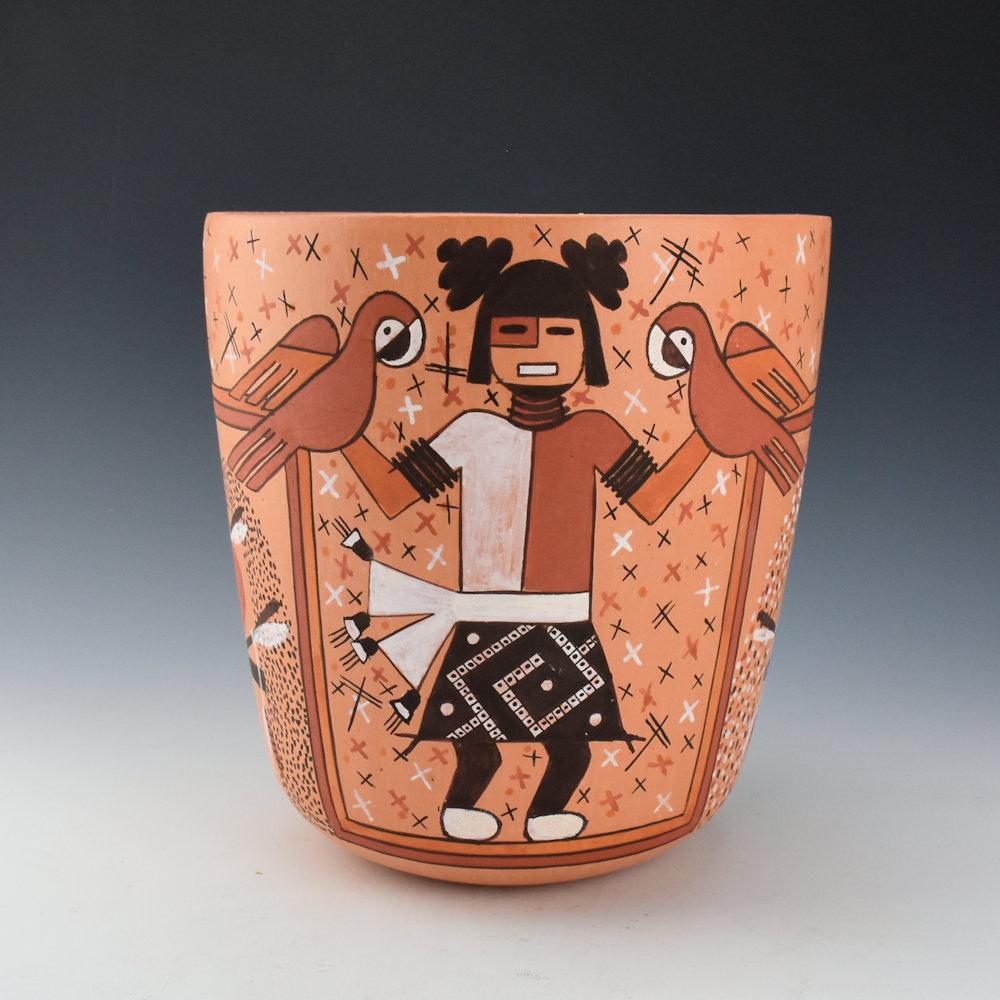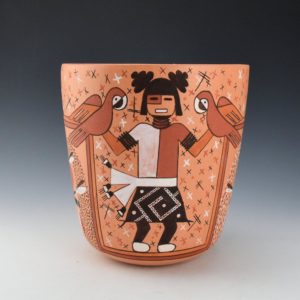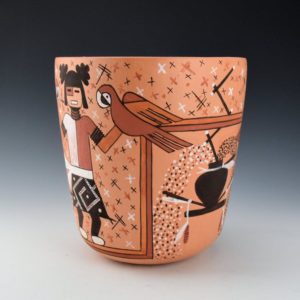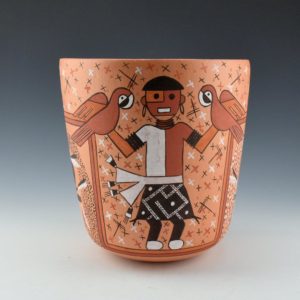- Photographs: Kin g Galleries
The images on this vase are a prayer for blessing, not mere decoration. Yet it was made to be sold, so it is also marked by commercial decisions. Both its iconography and dual pueblos of origin are complicated.
Form:
The vessel has a small flat base that becomes rounded as it curves upward to form the walls of the pot. Thus, while stable, slight pressure to the rim results in the vase rocking. The walls are even, quite thick, and rise with a slight outward slope, then narrow at the lip.
Bobby Silas, the artist, is Hopi but clay of this pot is not Hopi. It was either dug at Zuni, where Bobby lives, or is commercial. Pots by Anderson Peynetsa of Zuni are said to be made of local clay, and pot 2020-07 seems made of the same clay. A “thunk” with a finger on the lip of vase results in a high-pitched sound, clear evidence that the pot was kiln fired.
Design:
The design is a panorama of male and female celebrants, messenger birds, dragonflies, prayer feathers, cultivated fields and clay pots overflowing with an abundance of corn and pollen, all linked by a ribbon of rainbow. The style is directly derived from ancient kiva murals, as discussed below.
Central to the design are female and male celebrants. The woman is a maiden, as indicated by her hair whorls. her face and chest are segmented into red, white and tan sections, perhaps having directional meaning. A wedding sash encircles her waist. Below is a black kilt displaying a segmented crook, perhaps indicating the settlement pattern of a phratry house (Patterson, 1994:200). A very similar kilt is shown on an ancient mural, illustrated below, and a modern wedding vase by Jeanne Sahme, 2015-06. Black legs and oval white feet complete the image. As in the ancient mural pictured below, her arms are outstretched and holding macaw parrots, messengers to the gods. On the opposite side of the vase is exactly the same image except for the treatment of the hair. This second being is perhaps male since “he” lacks maiden hair whorls, his black hair being confined to a lunette. Unlike the maiden, his ears can be seen and carry circular earrings.
A “rainbow” formed by light and darker tan stripes encircles the pot making eight 90-degree turns and thus forming four linear panels. The rainbow surrounds the two celebrants on three sides, leaving the impression that these beings are standing in a shallow hole, feet on one segment of the rainbow, the two remaining segments to their right and left and the panel open above. The remaining two panels contain pottery, a red pot in one and the other containing a black pot, each sitting on a thick black line, a tabletop floating in the air. As with the two spirit beings, this pottery tableau is surrounded on three sides by the linear rainbow, but here the lower edge missing with a square arch of rainbow above.
From the mouths of each jar erupt two waterfalls of dots, which (according to the seller reflecting comments by the artist) represent corn and pollen, both used for blessings. The black dots I think represent pollen and the multicolor spray of black, tan and white dots represent multi-colored corn. What appear to be two black sticks positioned in the form of a “V” cradle each pot on the black “table top.” Hanging from each stick are two patois or prayer feathers, perhaps hawk and eagle. Single and larger white feathers are placed near the tips of this “V.” A third large white patois is affixed to the neck of the jar with a string. Emerging vertically from the mouth of the pots are four short slats pined together so they form a zig-zag, movable, form. This may be a “lightening frame” used by the katchinas to appeal for rain (Branson, 1992:229).
Above the linear “rainbow” is a pattern of design, like wallpaper behind the major design elements. Predominant among these background designs are large crosses with two horizontal cross pieces, a common pueblo image of dragonflies seeking water. According to Mark Tahbo, interpreting a pot by his great-grandmother Grace Chapella (2010-22) , the small “x” elements represent corn plants. Of course Bobby Silas might not have intended this interpretation.
Thus every element of design on vase 2020-07 adds to a chorus of consistent symbolic meaning: prayer, offerings, blessings, water and corn. Given the difficulty of farming at Hopi, these images are really a single prayer for life.
Historical roots:
The painting on this vase is detailed, spectacular and directly rooted in Hopi religious tradition. The style and iconography of the painting are derived from murals painted on the walls of ancient Hopi kivas. These murals were discover by White archeologists in the 20th century and have been a deep well of inspiration for Hopi artists.
A range of birds inhabits the murals of Awatovi discovered by archeologists in the 1930’s (Smith, 1952:183-189). Particularly prominent are Macaw parrots (Smith 1952:127, 180-181). Color drawings “E” and “I” of murals in Smith’s report show central figures with arms outstretched and parrots roosting on each wrist (1952: following p. 134). A drawing of this same image is published in McCreery and Malotki (1994:59). Macaws were never native to Arizona but were traded alive from Central America and laboriously carried north, though perhaps they were later bred in Arizona to provide a local source. Several macaw effigy pots are found in this collection: 2016-09, 2019-06 and 2020-08.
An ancient village in New Mexico labeled “Pottery Mound” by archeologists was excavated in the 1970’s and revealed kivas adorn with a wealth of murals. One image, dubbed “The Macaw Maiden” provided the model for the image on Bobby Silas’ jar (Schaafsma 2010:38):
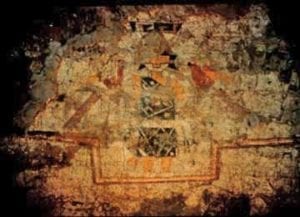
Michael Kabotie, Hopi painter and jeweler, was strongly influenced by these ancient murals (Behnke, 2013). Kabotie painted a mural incorporating the Macaw Maiden image and titled “Germination of Life” for The Museum of Northern Arizona in 2002. It is shown in Behnke (2013:165) and in this video:
(Click on highlighted words, above.)
It is probable that Bobby saw images of the Awatovi or Flower Mound murals or Kabotie’s mural at the MNA and was inspired by them.
Jeanne Shame painted the same Maiden image on a wedding vase, 2015-06. A similar image of a Polik’Mana with arms outstretched holding macaws is found on Jake Koopee’s vase, 2013-08.
Pueblo irony:
This vase and bird effigy 2020-08 were both made by Bobby Silas, a Hopi man living at Zuni, and purchased by me within a few weeks of their production. They are ironic artifacts of the long-term relationship between the Hopi and Zuni people.
As detailed in Appendix A, a series of smallpox epidemics in the 1700’s and 1800’s drove Hopi off their mesas and many resettled at Zuni Pueblo, 250 miles to the southeast. When the Hopi returned to their mesas, they brought with them a style of pottery called “Polacca ware” that looked Zuni but was made at Hopi.
Pots 2020-07 and 2020-08 by Bobby Silas are the reverse. As noted, the vase described here has designs derived from ancient Hopi murals. Bird effigy 2020-08 has both the form and design of ancient Hopi pottery. They look Hopi, yet both were made at Zuni, using Zuni clay and both were fired in a modern ceramic kiln. Polacca ware was made at Hopi but looked Zuni; these two pots were made at Zuni but look Hopi.
Bobby has lived at Hopi, used Hopi clay, and sometimes fired using lignite coal rather than dung, as did his Sikyatki ancestors. For examples see 2019-11 and 2022-13.
According to King Galleries, Bobby is now living at Zuni:
“He had originally learned to make pottery in 2004-5 when he attended Zuni High School. While he is Hopi-Tewa, he is again living in Zuni and has made a series of pieces inspired by classic Zuni shapes and designs (Published 11-9-20.).”
Jar 2020-07 has a simple, clean, shape and carries a beautiful design derived from ancient Hopi sources. That Bobbie is Hopi-Tewa but learned to make pottery at Zuni High School would surly make Daisy Nampeyo Hooee smile. She was also Hopi-Tewa, moved to Zuni, and started the pottery making class at Zuni Hight School in the 1950’s, where she taught the making of Zuni-style pottery. [See the catalog entry for pot 2011-13 for a discussion of Daisy’s career.] Daisy would certainly understand Bobbie’s dual roots at Hopi and Zuni and his success as a potter would please her.

